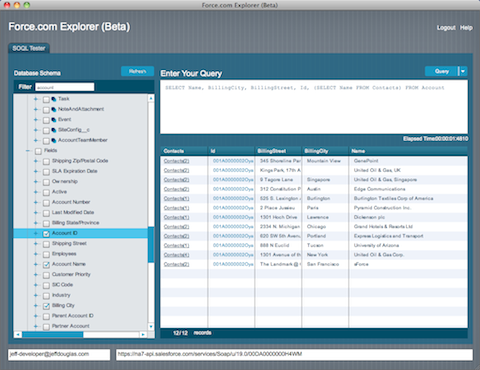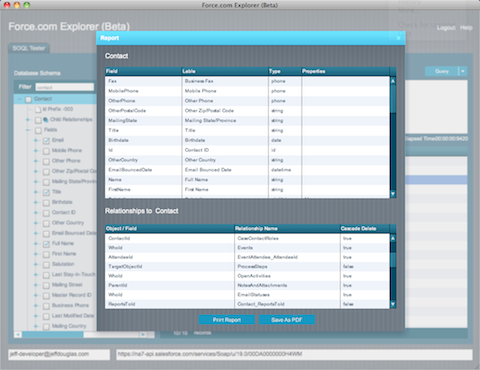A copy of the new Force.com Developer News arrived in my inbox this morning with some interesting news. An Adobe Air (beta) of the Force.com Explorer has been released for people to begin playing with. If you missed the newsletter, you can catch Jon Mountjoy's blog post with the announcement. Jon writes more eloquently than me due to his enchanting accent. You should give the app a whirl as it's off to a good start. You can download it here.
I was quite excited to see how the Adobe Flash Builder for Force.com was coming along since I developed a small app with the toolkit last January. I took a peek at the docs and they've made some really nice progress. However, the main reason I immediately downloaded the Force.com Explorer was to test out the functionality in hopes of a better tool. If you are a Mac user than you are blessed with the options of running Simon Fell's SoqlXplorer in addition to the Force.com IDE for Eclipse. Neither one is quite the perfect tool. SoqlXplorer doesn't let you drill into objects to build complex relationship queries like Eclipse but the Eclipse IDE doesn't allow you to copy the resulting data from queries into your clipboard. I typically live in the SoqlXplorer all day. (Side note: not being able to copy results in the Eclipse IDE is frustrating but Job Plax, the Force.com IDE PM, told me that this feature just missed the last release so hopefully it will be in a future release.)
The Force.com Explorer is a breeze to install if you already have Adobe Air and you can be up and running within seconds. It has a nice clean UI which looks a lot like the .NET Apex Explorer. It has most of the functionality that you find in the other SOQL query tool plus some:
- Filter objects by name
- Drill down into objects and relationships to create complex queries. Very similar in functionality to the Eclipse IDE
- Return results with child object that you can click on to drill into
- Copy the text from cells in the query results
- View metadata about the objects
- Query, query all and batch size options
- Right click on an object to view it of its metadata and save it as a PDF
- It remembers the fields you selected in previous objects to easily rebuild SOQL queries
Some issues that I found right away (BTW... email any issues or requests to developerforce@salesforce.com):
- I was not able to log into any sandbox orgs
- I had a problem printing the object report but could download it as a PDF with no problems.
- It crashed a couple of times while trying to create complex queries
- It was not able to construct queries with parent-to-child relationships and if I did manually enter them the results came back null.
View Metadata about an Object
</p>






